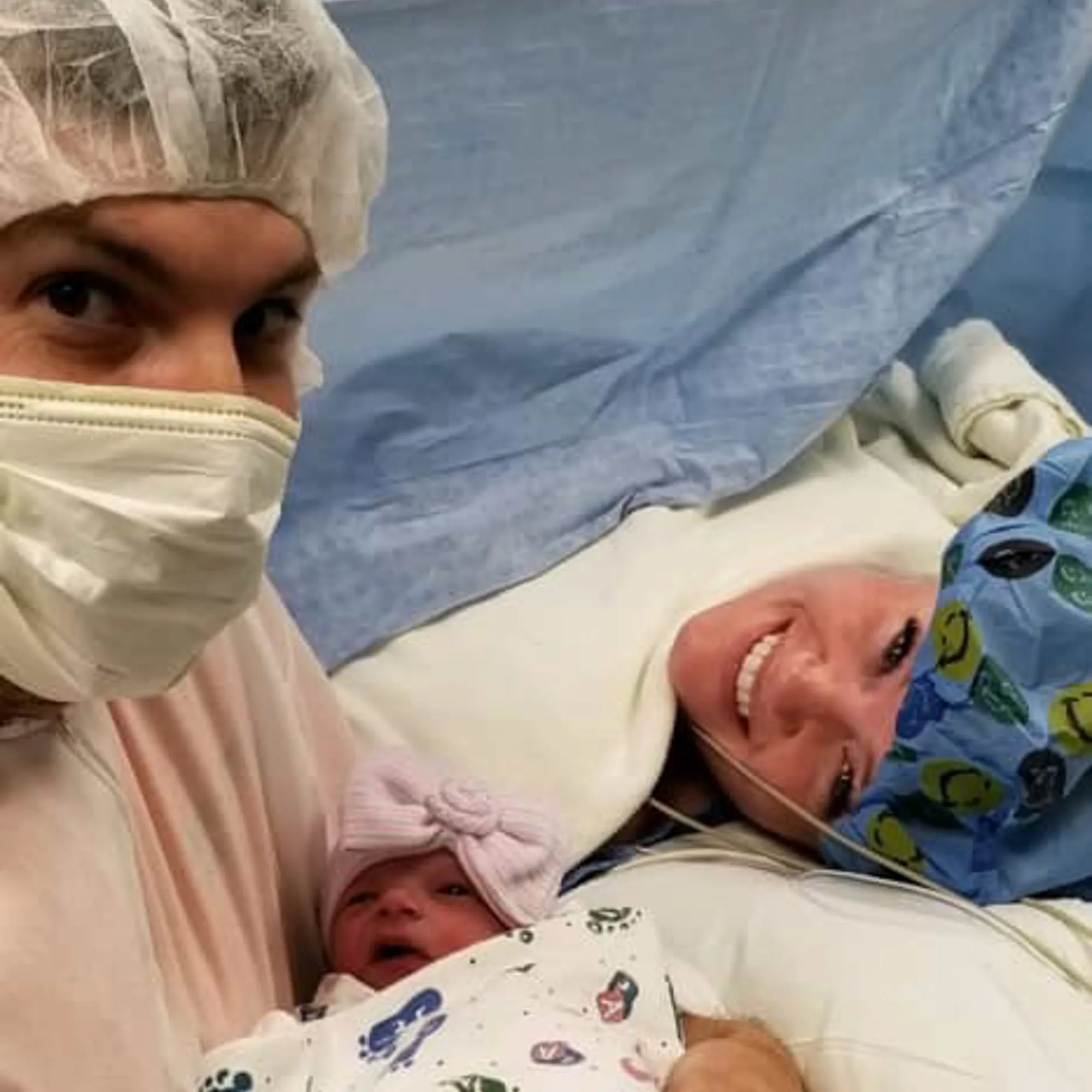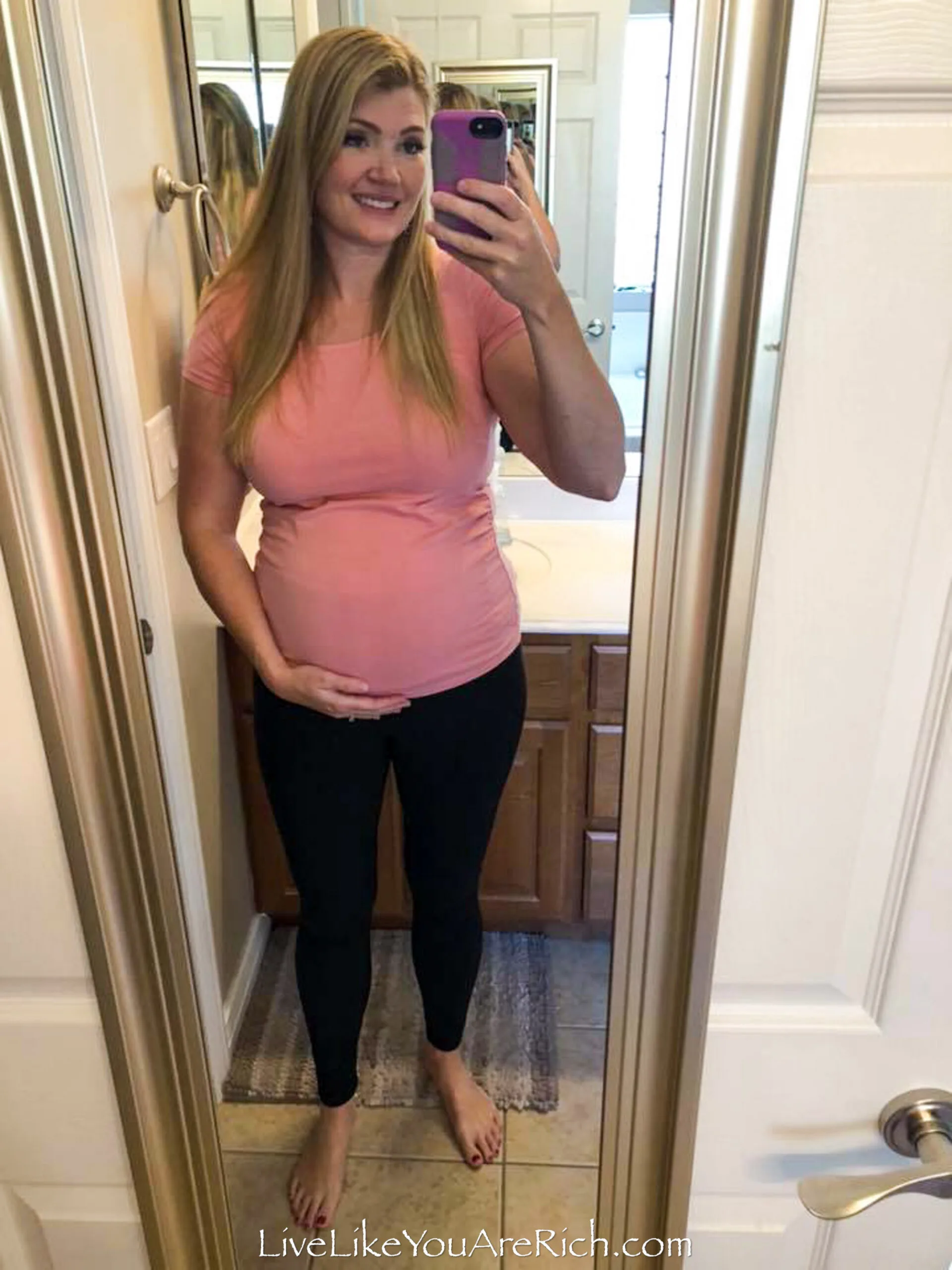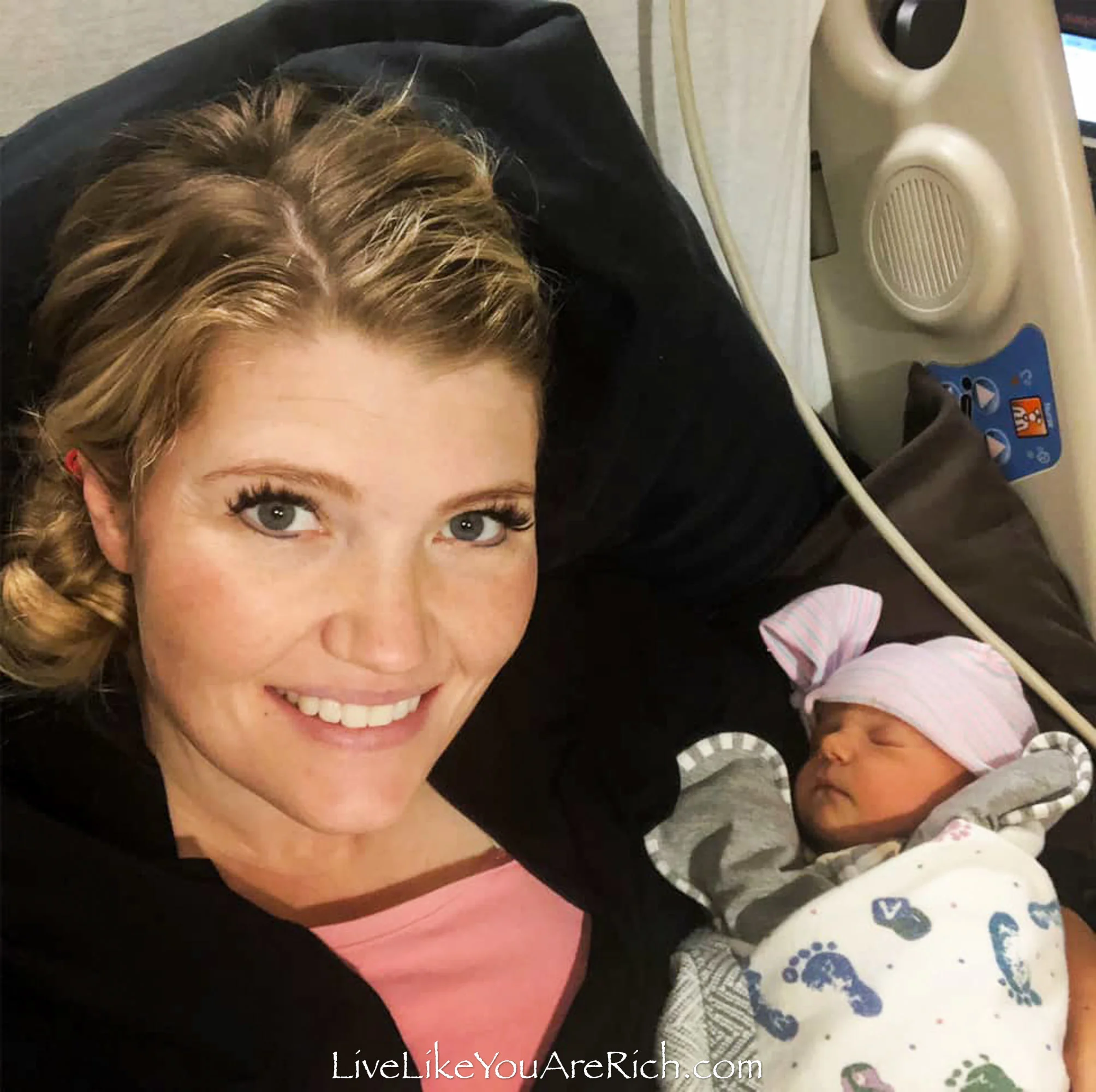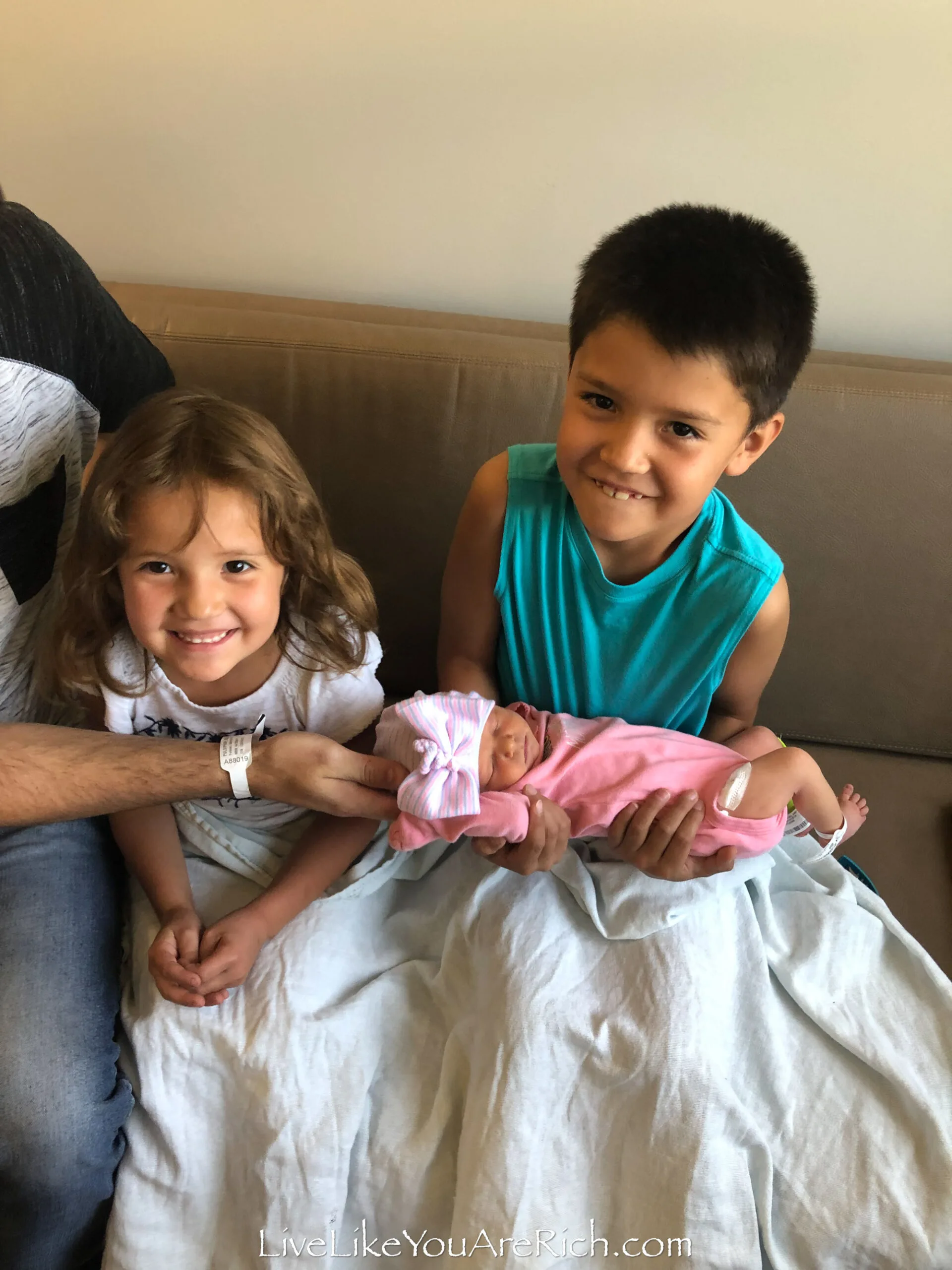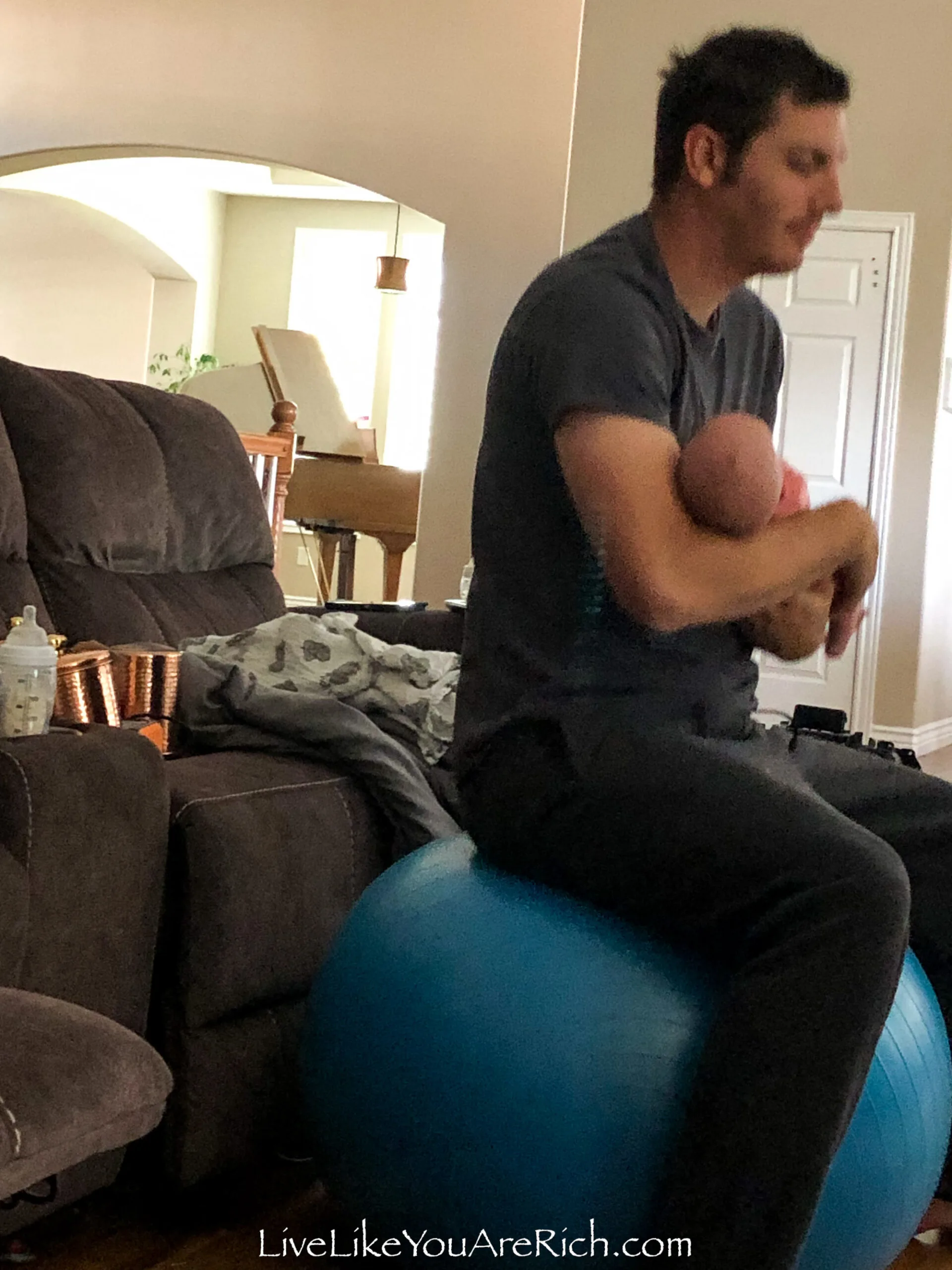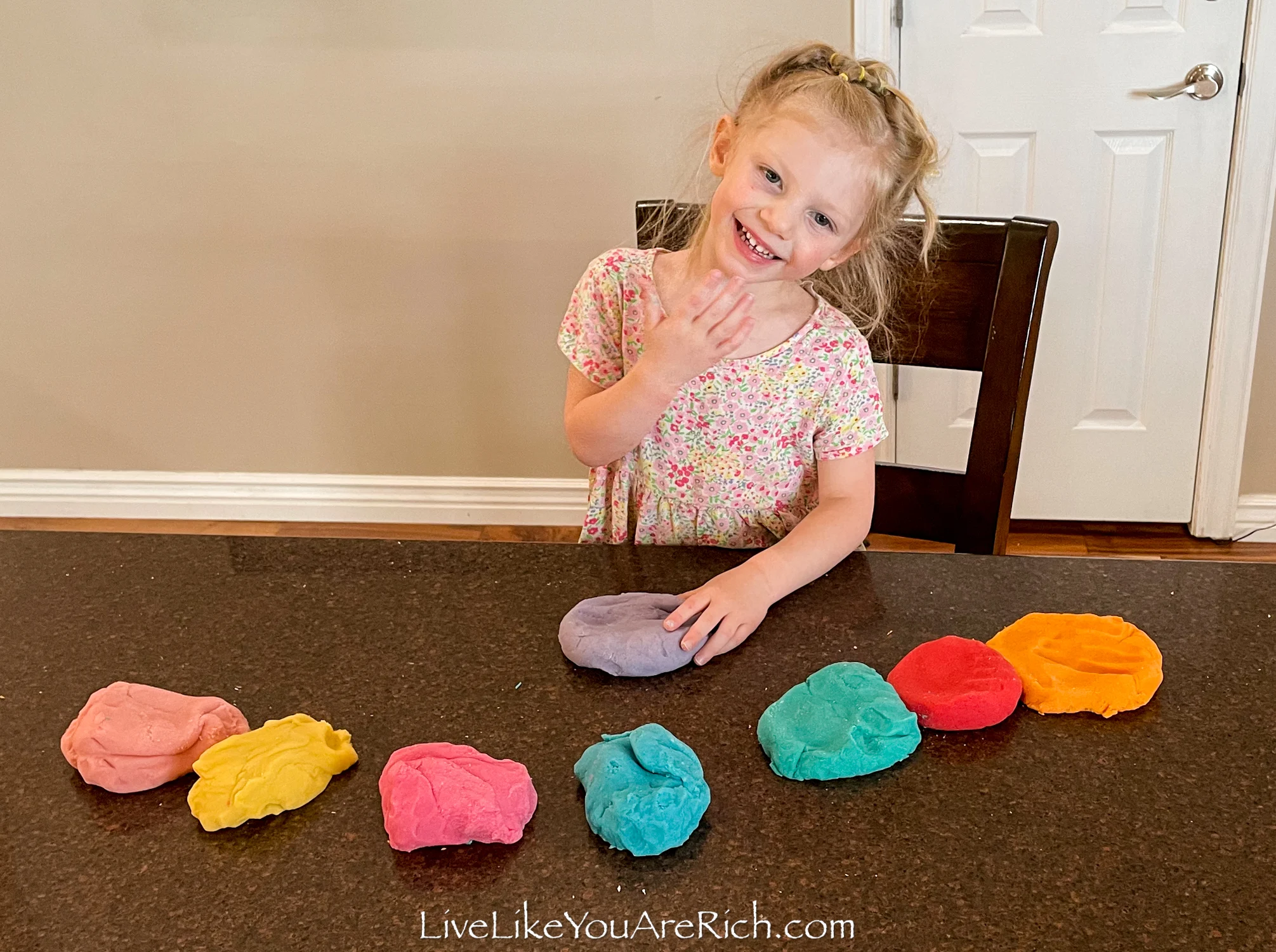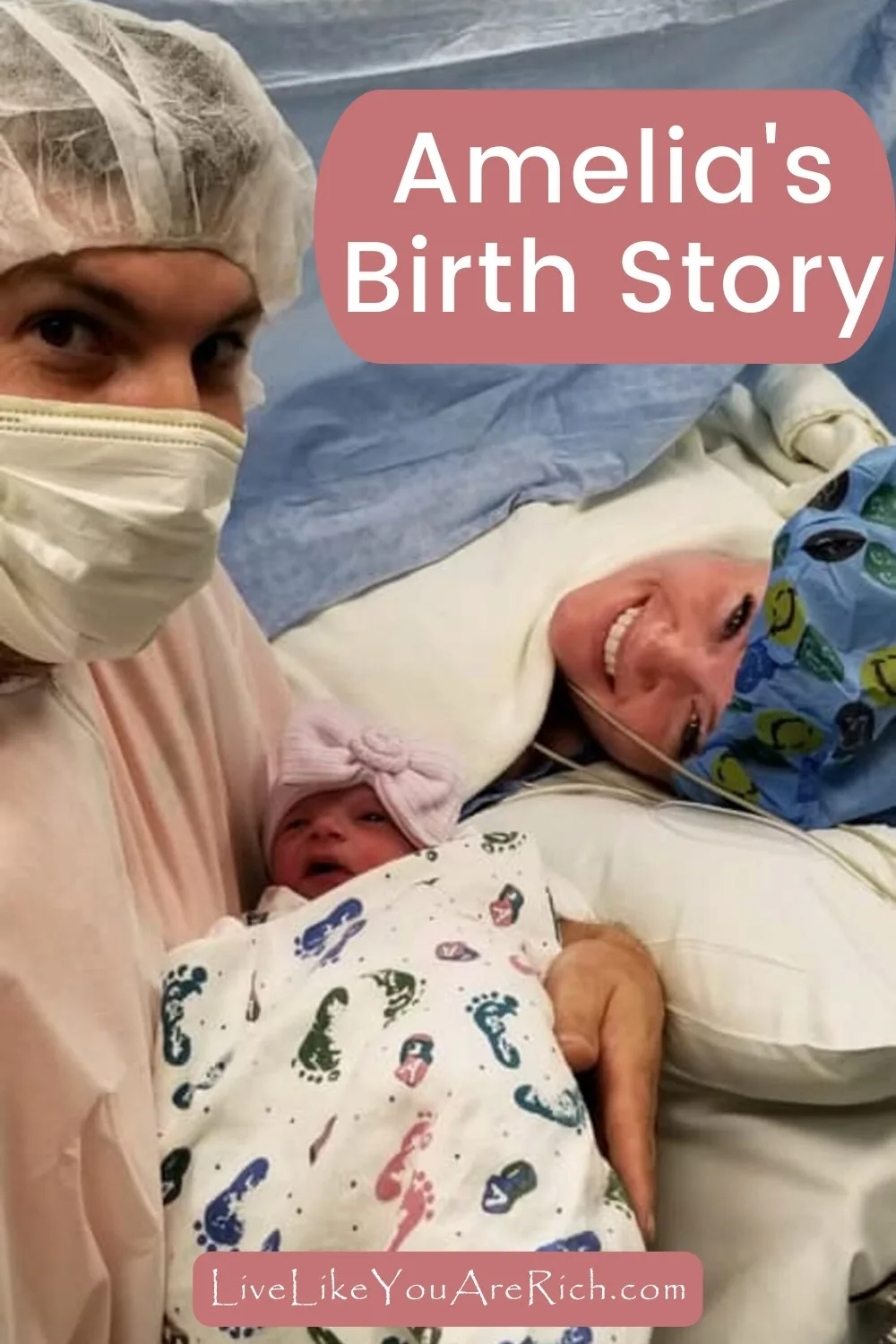My daughter, Amelia, just turned three and I haven’t written her birth story yet.
I usually share the stories of my children’s births on my blog in hopes that what I learned may help others.
Amelia’s pregnancy was, unbeknownst to everyone around me, high-risk.
This is a story I don’t want to forget and one that I think could help others as well.
My two oldest children were born when I was married to my ex-husband. My current husband, Shane, and I got married in October 2018. He did not have kids and I always wanted more. We were nearing 35 years old, so we decided to begin trying right after we married.
I got pregnant a month after our wedding and we were so excited.
I get pretty sick during my pregnancies and so January through April was no fun at all—especially as we were renovating Shane’s house in order to sell it. I was doing a lot of the work myself and managing and hiring contractors to do what we couldn’t.
My sickness made it very difficult to continue working at Shane’s house; throughout some of the winter months, I was forced to take a break. Since Shane was working full-time at his job this slowed the renovation progress significantly.
In the spring, I was feeling better and was able to begin working on the house every day again.
Just as a matter of interest, you can see the before and afters of his home reno by clicking here.
We made a lot of progress on his home in those few months that I was well before getting pregnant and sick, and then in my pregnancy months 5-7 I was feeling ‘sort of okay’ and we were able to make a lot of progress on his home and get it finished, staged, and listed on the market.
When nausea returned for the last few months of pregnancy— like it normally does with me— I also began having pre-term labor, and the house was under contract. It sold a week before Amelia came.
It turned out to be a great timeline for our renovation however, I would highly recommend that a woman not undertake to manage a full home renovation while pregnant—especially if she is prone to having difficult pregnancies. It was a challenge from start to finish.
When pregnant with my first baby seven years before, I had severe Pelvic Girdle Pain (more about that here). Luckily, with this pregnancy the PGP was bearable and I was able to walk throughout my pregnancy without too much pain.
My second baby came 5-6 weeks early spontaneously (Amelia is my 3rd), so the doctors put me on progesterone in hopes that it would help me deliver this pregnancy full-term.
I did quite a bit of research on it. I found out that you could take progesterone through shots, suppositories, or pills. I asked my doctor if I could take the pills, and thankfully he said I could.
I really enjoyed taking the progesterone in pill format. The reason is that I normally suffer from insomnia while pregnant. Taking the progesterone pills in the evening helped me sleep a lot better.
Despite being on progesterone, at 32 weeks I began contracting. I have what is termed prodromal labor. I have consistent contractions for months before labor. These are a little different than Braxton Hicks.
Braxton Hicks does not cause a thinning of the cervix or dilation. They are also not consistent and do not get closer together. Typically Braxton Hicks are not too painful and will stop with hydration, baths, lying down, rest, etc. Prodromal labor doesn’t always respond to these calming things. In fact, resting is often when they would come at their strongest.
Prodromal labor contractions do mimic real labor contractions but they are largely ineffective. They cause some thinning and dilation and they can and do mimic real contractions at times but they are not strong enough to be really productive in a day or even a few days, they usually take weeks or months to break the woman’s waters. They can also be called irritable uterine contractions.
Prodromal labor contractions are often consistent and increase in intensity but they do not help to progress the pregnancy along at a quick rate. They can even break the water if they go on for long enough (like with my first and second babies), but with bed rest and a lot of care, progesterone, and nifedipine, I was able to hold onto my last two pregnancies for longer than my first two.
Basically, the contractions suck. Women who have prodromal labor may also be told they have an irritable uterus. From what I’ve been told, irritable uterine contractions are another name for prodromal labor.
I would contract consistently sometimes for four or five hours at a time. It was exhausting.
After having contractions/strong cramps for that long consistently, I would be exhausted and they felt more painful just due to the fact that my muscles were tired.
Baths, lying down, standing up, guzzling water, etc. would not stop them. They would spontaneously start and spontaneously stop.
Some people may be confused as to what this is and if women who have given birth before haven’t experienced anything like it, they may think we are making this up. Well, we aren’t.
How do I know? Well, first, I could feel them.
I knew when they came on, the height of the contraction, and when they died off. They were easy to track.
Second, others could feel them.
My stomach would turn into a hard ball of contraction. During my checkups, my doctors would comment on how hard a contraction was at that particular moment and I would say, oh that’s just normal, I contract like this all day long every day. I always received a lot of compassion when they realized the extent of my pain.
And third, since I had so many false alarms I went to the hospital multiple times for monitoring and the contractions were easily seen and rated on the intensity scale with the labor equipment.
I was always put on a contraction monitor and it would read the contractions as powerful and frequent.
In fact, my prodromal labor contractions were so powerful and consistent that when I was under observation they kept me there for hours each time we went in. I’d have to see the doctor or multiple nurses before they sent me home to prove that I wasn’t truly in labor.
While being monitored they would be giving me tons of water to guzzle and many were genuinely perplexed as to why I wasn’t dilating or progressing. Often I was given medicine to try and calm the contractions down.
These contractions occurred with ALL four of my pregnancies and it was absolute torture.
With my first son, they only occurred for 2 weeks and were only really strong for about 7 days leading up to breaking my waters and his one-week early birth.
With my daughter, they started a few months before she was born and wouldn’t stop at all for seven days until they ended up breaking my waters—so I had her 6 weeks early.
With Amelia (this baby’s birth story), they started two months early but I was on progesterone and bedrest, and with Brighton (I haven’t written about that labor yet), they began four months early. Brighton is our last…for sure!
I just do not think I could go through that again.
At 33 weeks, my contractions were becoming increasingly frequent and steady. I went into labor and delivery due to the contractions.
The doctor gave Amelia a steroid shot of Antenatal corticosteroids to strengthen her lungs just in case my water broke.
Then they gave me a shot that felt almost like a sedation shot. It made me feel like I had run a marathon and then a few hours afterward, once I was home in bed, I lost feeling in my legs and arms for a few hours. After I regained feeling in my legs and arms I was able to google it and found that that particular side effect is cause for alarm. Since I couldn’t really move, I just fell asleep. I slept it off and felt a little better, yet very groggy in the morning. If this happens to you though, you should have someone call in for you.
It was a terrible shot and I vowed I’d never get it again, but it did stop my contractions for multiple days. I did end up having to get this same shot multiple times while pregnant with my 4th pregnancy. UGH.
After this pre-term labor scare, I was put on partial bedrest for the next 7 weeks in hopes that that would keep my contractions at bay. It did not. I still had them consistently while I was on bed rest.
At 36 weeks I had another false alarm. I went into labor and delivery after my contractions were consistently 4 minutes apart for over two hours.
After checking and monitoring for a few hours I had not dilated or thinned out very far, so I was sent home.
37 weeks:
At 38 weeks I woke up and it felt as if my water was slowly leaking along with the consistent contractions I was having that morning. I called the nurse on the phone who told me to go in. Luckily I did!
When they hooked up the monitor at the hospital, Amelia’s heartbeat was going down after each contraction. They monitored me for a few hours and since it wasn’t too alarming, I was sent home. I didn’t realize this at the time, but Amelia was in the beginning stages of fetal distress. Had I known she was struggling, I would not have left.
I didn’t know what to look for on the monitor in relation to her heartbeat and my contractions, but I did hear the nurses arguing in the hallway as to whether to keep me or send me. Then I was told to go home. I found out later, that that was the wrong call… and so did the OB who worked the next hospital shift.
The following day, by a miracle, my husband got off work very early (this never happens in his busiest season). He walked in at about noon—just as I got a call from the doctor at the hospital. She had reviewed the stress test I had had the day before and she was very concerned about Amelia’s heartbeat.
She asked me if I had felt Amelia moving and I said no, she wasn’t moving much at all. She told me to come in immediately.
My husband and I went in right then. About 15 minutes after the call I was in the hospital being monitored. They saw via Amelia’s heartbeat that she really wasn’t doing well at all.
With each contraction, her heartbeat would dip significantly. Just when her heartbeat would recover, I contracted again and her heartbeat would get dangerously low again. She was in fetal distress.
I had given birth vaginally to my others and did not want a C-section. I asked if there was an alternative, and they said that while I got an epidural and was prepped for an emergency C-section, they would see how quickly I progressed.
They broke my water and saw it was very dark. Not a good sign. There was a lot of meconium in the water.
It was at this point that Amelia began having an even harder time recovering after each contraction. Her heart rate was not getting to a normal point, she was constantly suffering—as my contractions were too strong and too close together.
At that point, they rushed me into the operating room and 10 minutes later, as Shane was holding my hand and helping me manage my fears, we heard Amelia’s first cry. What a relief!!!
Then I heard the doctor say, “She is so tiny!” I thought, ‘How can that be?”, my 6-week-early baby was 6 pounds! My son who was one week early was 8 1/2 pounds. Amelia was 39 weeks and weighed 5 pounds 3 oz.
Then the doctor said the umbilical cord was wrapped around her neck four times and began remarking on how strange it was as well as my placenta. She said, “This is the longest chord I have seen.” “This placenta is not healthy.” The placenta was calcifying and had a very strange appearance. She told the nurse to send it to the lab for a diagnosis.
Weeks later, after a biopsy, they found that it was dying/calcifying and that there was a tumor growing on it. Luckily the tumor was benign (noncancerous).
This happens to less than 1% of pregnancies and can cause malnutrition and a host of other issues for the fetus which is why Amelia was so tiny. She was struggling to get nutrition.
My OB said that had I stayed at home for one more day Amelia wouldn’t have made it. I believe that to be true as my waters were very dark, Amelia had been in distress for at least 24 hours and her lifeline/placenta was failing.
I am so grateful to Dr. Cloward for double-checking the stress test that I had the previous day and calling me in!!
We were so blessed that despite her weight, Amelia was in good health.
She had great lung strength (which I attribute in part to the steroid shots she had to strengthen her lungs), and she had consistently good blood sugar levels, and we were able, with my husband’s help, to keep her warm and comfortable.
After my recovery, she came home with us at 4 pounds 10 oz.

Amelia began to put on weight at a good steady rate.
She was bottled and formula-fed due to a health condition I have.
The doctors were actually very relieved she would be bottle-fed so that we could monitor her intake.
We had to weigh her diapers and formula and ensure she was eating well.
Despite eating well, she was a VERY colicky baby. She cried a lot!!
My husband and I found that bouncing her on the exercise ball as one of us held her was about the only thing that would help her settle down and not scream.
We found a sensitive formula that helped a little with her crying and I used Windi’s to relieve her of her gas and help with bowel movements that were making her absolutely miserable. The Windi’s helped her immensely.
She became much less colicky once we figured out she was having digestion and gas issues.
We watched her very carefully during the first months and even though she was 1% in weight for her age for a while, she progressed nicely.
Her pediatrician was very happy about her health progress.
Now, she is a very healthy child.
Her pediatrician called her, “an Amazonian” at her three-year-old check-up as she is very tall, muscular, and lean.
The main thing that I learned from this pregnancy and which I corrected in my fourth pregnancy was how important it is to get stress tests done (and to demand them) if you are in a high-risk situation or are concerned at any time with fetal movements and contractions.
I also learned how important it is to check the baby’s movements each day in the last few months leading up to labor. I definitely did this with my next baby.
I also asked the nurses what the heartbeat and contraction correlation was so I could watch for it myself during the stress tests.
I learned that women who choose to eat their baby’s placenta should have it biopsied/ thoroughly checked by a professional before they consume it. I did not know tumors can grow on placentas but they can and sometimes they are cancerous.
A lady who lived on my street, who I met after Amelia’s birth, told me that she got cancer because she consumed her son’s placenta and unbeknownst to her there was a cancerous tumor on it. The Placenta Cancer spread incredibly fast throughout her body because, according to what she told me, placenta cancer grows very quickly.
She was hospitalized and had to have intense chemo and radiation while her son was a newborn. It was so sad to hear about.
It is VERY important for a woman who is going to consume her baby’s placenta to have it thoroughly checked for tumors and cancers beforehand.
I also experienced again how very blessed I am. I am very blessed to be living in this day of modern medicine!
Had I had this type of pregnancy 100 years ago, my child and/or I would likely not have survived.
I am so blessed to live near a hospital with so many competent healthcare professionals.
I was so incredibly grateful for the doctor, Dr. Cloward, who called me in after looking at Amelia’s stress test.
I delivered a huge bouquet of flowers to her a few weeks after recovery thanking her for going above and beyond in our care.
She saved Amelia’s life; for that, I am eternally grateful.
Amelia is such a fun, imaginative, social, spunky, intelligent, and sweet girl.
We couldn’t imagine life without her.
I hope this birth story helps even just one person out there.
If you have additional questions, feel free to leave them in the comment section below.
For other ‘rich living tips’ please subscribe, like me on Facebook, and follow me on Pinterest and Instagram.
SUBSCRIBE FOR OUR EMAILS

